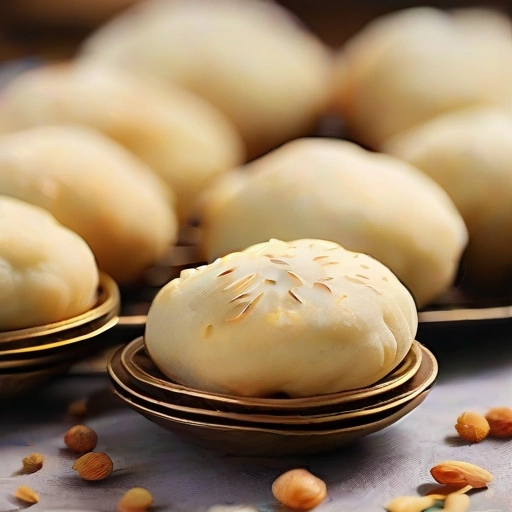Maandazi
Maandazi Recipe from Kenya: How to Make Delicious Fried Doughnuts
Introduction

Maandazi is a popular East African fried doughnut that is enjoyed as a snack or dessert. It is a delicious treat that is perfect for any time of day.
History
Maandazi has its origins in East Africa, where it is a traditional snack that is often enjoyed with tea or coffee. It is a popular street food and is also commonly made at home for special occasions and celebrations.
Ingredients
How to prepare
- Mix the dry ingredients together and then add the egg and milk. Mix well until everything is combined.
- Roll out the dough to a thickness of about 0.75 inches, similar to a jellyroll.
- Use a doughnut cutter with the center ring removed, or an upside-down glass, to cut out the doughnuts.
- Fry the doughnuts in hot oil at a temperature of 365°F (185°C) until they turn golden brown.
- This recipe yields approximately 1 dozen doughnuts.
Variations
- Add a teaspoon of vanilla extract for extra flavor.
- Sprinkle the maandazi with sesame seeds before frying for a crunchy texture.
Cooking Tips & Tricks
Make sure the oil is hot enough before frying the doughnuts to ensure they cook evenly and become crispy.
- Do not overcrowd the pan when frying the doughnuts, as this can lower the oil temperature and result in soggy doughnuts.
- Dust the maandazi with powdered sugar or cinnamon sugar for extra flavor.
Serving Suggestions
Maandazi can be enjoyed on its own or with a cup of tea or coffee.
Cooking Techniques
Frying
Ingredient Substitutions
You can use coconut milk instead of regular milk for a richer flavor.
- You can use whole wheat flour instead of all-purpose flour for a healthier option.
Make Ahead Tips
You can prepare the dough ahead of time and refrigerate it overnight before frying.
Presentation Ideas
Serve the maandazi on a platter with a dusting of powdered sugar for a beautiful presentation.
Pairing Recommendations
Maandazi pairs well with a hot cup of chai tea or coffee.
Storage and Reheating Instructions
Store leftover maandazi in an airtight container at room temperature for up to 2 days. Reheat in the microwave for a few seconds before serving.
Nutrition Information
Calories per serving
Each serving of maandazi contains approximately 200 calories.
Carbohydrates
Each serving of maandazi contains approximately 20 grams of carbohydrates.
Fats
Each serving of maandazi contains approximately 10 grams of fats.
Proteins
Each serving of maandazi contains approximately 3 grams of proteins.
Vitamins and minerals
Maandazi is not a significant source of vitamins and minerals.
Alergens
Maandazi contains gluten and eggs.
Summary
Maandazi is a delicious treat that is high in carbohydrates and fats, making it a rich and indulgent snack.
Summary
Maandazi is a delicious East African fried doughnut that is perfect for snacking or dessert. With a crispy exterior and soft interior, it is a treat that is sure to please your taste buds.
How did I get this recipe?
I can still picture the first time I came across this recipe for Maandazi, a traditional East African doughnut-like pastry. It was many years ago, during a trip to Kenya, where I had the pleasure of staying with a local family in the coastal town of Mombasa.
I remember waking up to the smell of freshly brewed chai and the sound of laughter coming from the kitchen. As I made my way downstairs, I was greeted by Mama Fatuma, the matriarch of the family, who had a warm smile and a twinkle in her eye. She was busy kneading a rich dough and shaping it into small rounds, which she then fried to a golden crisp in a large pot of bubbling oil.
Curious to learn more about this delicious treat, I eagerly offered to help Mama Fatuma in the kitchen. As we worked side by side, she shared with me the story of Maandazi and how it had been a staple in her family for generations. She told me that the recipe had been passed down from her grandmother, who had learned it from a Swahili trader who traveled along the coast selling spices and goods.
As we fried batch after batch of Maandazi, Mama Fatuma shared with me the secret to making them light and fluffy. She explained that the key was to let the dough rest and rise before shaping and frying it, allowing the flavors to develop and the texture to become airy and tender.
After hours of kneading, frying, and laughing together in the kitchen, Mama Fatuma presented me with a plate of freshly made Maandazi, dusted with powdered sugar and served with a steaming cup of chai. As I took my first bite, I was transported back to my own childhood, where my own grandmother had taught me the joy of cooking and the importance of sharing recipes with loved ones.
From that day on, Maandazi became a cherished recipe in my own collection, a reminder of the warmth and hospitality of Mama Fatuma and the rich culinary traditions of East Africa. Over the years, I have perfected the recipe, adding my own twist with a hint of cardamom and a drizzle of honey for sweetness.
Whenever I make Maandazi now, I think of Mama Fatuma and the memories we shared in her kitchen. I am grateful for the lessons she taught me about the power of food to bring people together and the importance of preserving family traditions through recipes passed down through generations.
And so, as I shape the dough and fry the Maandazi in my own kitchen, I am filled with gratitude for the journey that led me to this delicious recipe and the friendships that have enriched my life along the way. As I savor each bite of the golden, crispy pastry, I am reminded of the love and laughter that transcends borders and connects us all through the shared experience of food and fellowship.